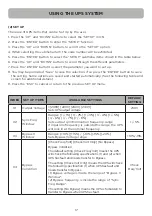
5
INSTALLING YOUR UPS SYSTEM
7. To maintain an optimal battery charge, leave the UPS connected to AC electrical service at
all times.
8. Before storing the UPS for an extended period of time, turn the unit OFF. Then cover it
and store it with the batteries fully charged. Recharge the batteries every three months to
ensure good battery capacity and long battery life. Maintaining a good battery charge will
help prevent possible damage to the unit from battery leakage.
9. The UPS has one USB port (default) and one Serial port that allow connection and
communication between the UPS and any attached computer running the PowerPanel®
Business Edition Agent software. The UPS can control the computer’s shutdown during a
power outage through the connection while the computer can monitor the UPS and alter
various programmable parameters. Note: Only one communication port can be used at
a time. The port not in use will automatically become disabled or the serial port will be
disabled if both ports are attached.
10. EPO (Emergency Power Off) / ROO (Remote on/off) Port: EPO/ROO ports allow
administrators the capability to connect the UPS unit to customer-supplied EPO/ROO
switches. If EPO is enabled, these installations give operators a single access point to
immediately power-off all equipment connected to the UPS during an emergency. If ROO is
enabled, these installations give operators an access point to turn on/off UPS remotely.
11. To avoid electric shock, turn the unit OFF and disconnect the unit from utility power before
hardwiring the UPS (in/out power cord). The in/out power cord MUST be grounded.









































